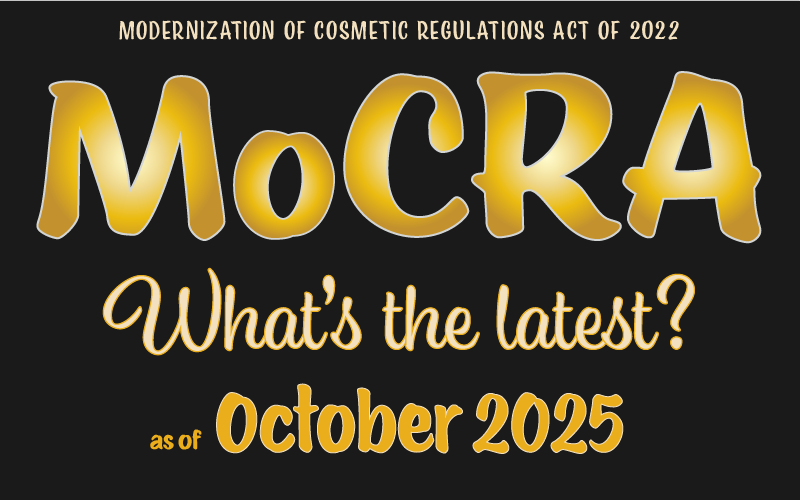The FDA’s progress on implementing the Modernization of Cosmetics Regulation Act of 2022 (MoCRA) continues to move forward—though not as quickly as many in the industry had hoped. The recently released Fall 2025 Unified Agenda provides the clearest picture yet of what’s coming, and when.
What the Unified Agenda Is (and Isn’t)
The Unified Agenda is published twice a year; the most recent edition was the Spring 2025 Unified Agenda, published on September 4th (yes, it’s the Spring edition). It lists all of the regulatory actions agencies are considering addressing in the next 12 months.
The Spring 2025 List showed that the FDA is considering 23 rules in the “proposed rule stage” and 25 rules in the “final rule stage.” Of those, two relate to cosmetics: Fragrance Allergens (required by MoCRA) and the use of formaldehyde and formaldehyde-releasing chemicals in hair smoothing or straightening products.
It’s important to note that the Unified Agenda is a planning tool, not a guarantee. Some items move faster, some slower, and some never make it past the planning stage, and some regulations get proposed and finalized without ever making it into the Unified Agenda. Still, it’s our best roadmap for what regulations the FDA intends to move on, including the required MoCRA regulations.
Fragrance Allergen Labeling
One of MoCRA’s requirements is that cosmetic labels disclose the presence of certain fragrance allergens and it required the FDA to publish a list of the fragrance allergens that had to be declared by June 29, 2024. That deadline has come and gone.
In the previous Unified Agenda (Fall 2024 Agenda), the FDA stated it might consider either shortening the compliance date or an alternative labeling requirement, such as a more general allergen statement. At that time, it gave a timetable for action by January, 2025 (which also didn’t happen).
The current Fall 2025 Unified Agenda does not mention the FDA considering alternatives. It now shows:
- MoCRA deadline: June 29, 2024
- Proposed Rule Expected: May 2026
In other words, they are thinking they’ll have a proposed rule published by May, 2026. From the issuance of the proposed rule there is still a long runway before the final rule is approved, issued, and goes into effect.
For makers, this means fragrance allergen labeling won’t be finalized until at least 2027, depending on how long the process takes.
Good Manufacturing Practices (GMP)
MoCRA also required the FDA to issue regulations establishing good manufacturing practices for cosmetic facilities by December 29, 2024 (which didn’t happen). These rules are expected to set standards similar to those already in place for food and dietary supplements.
The previous (Fall 2024) agenda had the GMP regulations in the proposed rule stage, with an expected date of October 2025 (that didn’t happen either).
In the current Unified Agenda, cosmetic GMP regulations have been classed as a “long-term action” which basically means that they are putting it off (at least for now).
Key points from the Unified Agenda:
- MoCRA Deadline: December 29, 2024
- Proposed Rule Expected: Unknown, but not within the next 12 months
This delay means businesses should continue operating under existing nonbinding FDA guidance for GMP and that there are no regulatory requirements set (yet).
Why the Delays?
Well, first off, the FDA has never been super-fast on getting regulations issued. Consider the regulations to require metric measurements in the net contents statement. A law requiring metric measurements was passed in 1992 and the FDA issued proposed regulations for cosmetic labels in 1993. It was never finalized, and finally, in 2004 (11 years later), the FDA withdrew the initial proposal. We have to do it because it’s law … not because the FDA ever got around to issuing any regulations clarifying how to do it.
Secondly, there’s been some considerable upheaval at the FDA this year. The Agency was reorganized in the end of 2024, and by early 2025 we had a new head of Cosmetics and Colors and a new head of the FDA. And, of course, there are fewer personnel as well.
Finally, the Trump Administration’s new regulatory approach is part of the reason. Under Executive Order 14192, agencies must follow a “one-in, ten-out” rule: ten regulations must be removed for every new one finalized. That has slowed the pace of new rulemaking, even for statutory requirements like MoCRA.
What Makers Should Do Now
Even without final rules in place, you can prepare:
- For fragrance allergens: Start tracking the allergens already required in the EU. These are likely to overlap with the FDA’s final list.
- For GMP: Review FDA’s draft guidance on cosmetic GMPs. All of the practices—clean facilities, proper documentation, quality checks—are recognized as industry best practices. Even without regulations, you should have your systems in place to make clean and safe products.
Final Thoughts
The Fall 2025 Unified Agenda confirms what many suspected: MoCRA’s implementation will stretch well beyond its statutory deadlines. While frustrating, it also gives cosmetic makers more time to get systems in place. If you start documenting any fragrance allergens in your products based on the EU lists, and implement GMP-style operations now, you’ll be ahead of the curve once the FDA does get around to proposing and finalizing the rules.


Leave a Reply